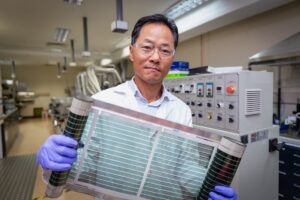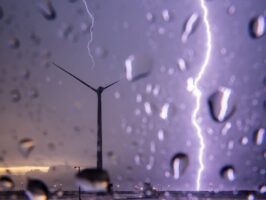This article has been written in response to an article posted earlier this week by the Senior Climate and Energy Advisor at the Australian Council of Social Services (ACOSS).
The ACOSS article seeks to correct what it said were “mis-conceptions and false accusations” in the public debate about the AEMC’s proposed rule to allow networks to charge distributed generators to use the grid.
ACOSS’s article references my previous contributions – here and here – as the source of such mis-conceptions and false accusations. These are serious claims to make. ACOSS is a respectable organisation and I am a university professor and Director of the Victoria Energy Policy Centre.
Enough background, on with the debate. Here is my open letter to ACOSS in response.
“Dear ACOSS, thank you for your article. You make many points in it. Let me please respond to the main ones in the order you present them.
First you suggest that I am mistaken in suggesting that there are not bottlenecks in the network. But I did not suggest this.
I suggested that there may be problems and I adduce evidence – based on the distributors’ regulatory proposals and the AER’s decisions – that the problems are evidently trivial since fixing them will require an amount of expenditure that will raise distributors’ regulated revenues by around 0.1% (which is about 0.03% of the typical residential electricity bill).
You do not contest this analysis but instead point to your claims of the views expressed by the Australian Energy Market Operator (AEMO), the Australian Energy Regulator (AER) and SA PowerNetworks (SAPN) to support your claim that there are bottlenecks. Let’s examine those references:
- Your AEMO reference is to the web page of the 2018 Electricity Statement of Opportunities. That document (now three years old) makes no claim about bottlenecks associated with distributed energy.
- Your AER reference is to the AER’s 2019 consultation on their approach to assessing distributed energy resource expenditure. There is absolutely no claim in that document of bottlenecks.; and
- Your SAPN reference is their Annual Planning Report. That documents has 1.5 pages (out of 158) to describe network issues associated with distributed generation. In those pages there are general descriptions and references to weaknesses in measurement that concludes the problem is generally not well understood. How should we understand this? In its most recent regulatory control, SAPN sought and was allowed capex of $82m for the five years ending in 2025 for “distributed energy management”. This is 5% of their $1.6bn capital expenditure allowance. Or to see it from the customer’s point of view, this will add about $5.9 to the typical SAPN customers’ bills after all the $82m has been spent. SAPN has the highest rooftop solar penetration in Australia (around one in three homes). How can you conclude from this that there is a major problem of bottlenecks?
Your also make claims about “thermal over-loading of substations” (which again references the 2018 ESOO which says nothing of the sort); and “existing voltage issues” (your reference returns “page not found”).
Finally you reference an article by Clay Lucas, a journalist for The Age, which explains that 2023 Powercor customers had been refused any rooftop solar export to the grid in the last 18 months.
But you ignored the evidence in my article where I explained that I was one of these 2023 customers and when I asked Powercor to justify their refusal of my application by showing me their calculations, they changed their mind and said I could export the 5 kW that I applied for.
When I asked them to explain why they changed their mind, they refused.
You look at this evidence and assume it is indicative of a network bottleneck? Might a more plausible conclusion be that it is a manifestation of monopoly abuse?
Finally you claim that AEMO predicts that by 2025 a quarter of all “network” substations will experience reverse power flows by 2025. Again you reference the 2018 ESOO which in fact makes no such claim.
But even if a quarter of all transformers experienced reverse power flows, where is the harm in that?
In fact, does ACOSS actually believe any of the claims that are made in your article? For example, later in your article you say “Networks have indicated the costs to date of adding solar PV have been relatively low as they ‘use up’ the intrinsic hosting capacity of the network.”
Right, so then what you actually believe is that there is no big issue now, but that there will be at some point in the future?
Putting this together, would you not agree that you have failed to refute my argument that “bottlenecks”, to the extent they really exist (and your references do not dispel my conclusion that the evidence of this is at best dubious) can be easily remedied?
Does the accusation of “mis-conception and false accusation” actually lie a little closer to home?
Let’s turn to the next issue, whether households with rooftop solar are being subsidised by non-solar households.
The first argument you make is that through the Small Scale Renewable Energy Scheme rooftop solar is subsidised by all customers. You then seem to dispel this by saying “but that’s another matter”.
Not so quick. It is true that almost all electricity customers pay for the SRES subsidy (some of the trade-exposed industrial customers are largely excluded).
Customers also pay for the much bigger large scale renewable subsidy (LGC) – which you do not mention. Why do you not mention this?
Renewable energy subsidy is the policy of a democratically elected government. Are you suggesting that network charges for rooftop solar exports should be introduced by an unelected body, the AEMC, to neutralise a democratically accountable decision that you (and you speak for ACOSS also, no?) do not like?
Should ACOSS not be expressing these views in its political campaigning rather than trying to use administrative processes to square things away as it seeks?
The second argument you make is that households that install rooftop solar buy less electricity from the grid and so cause other households to pay more for the foregone income that their monopoly distributor would otherwise collect.
You provide no evidence of the magnitude of this.
We have studied this – as you know because I sent the document to you many months ago – and quantify this in Victoria at 0.13 cents per kWh, or about 0.34% of the typical residential bill. This sounds trivial to me. Are you suggesting otherwise?
If nonetheless you insist that foregone distributor income is a problem that needs to be addressed, then why do you not raise this same argument in relation to people who reduce their consumption in order to reduce their bills, by installing more efficient appliances or simply using electricity by sweating through a hot summer?
This has exactly the same effect on distributor prices as happens when consumers install rooftop solar.
More generally your logic suggests that someone who exchanges a big gas guzzling car for a small fuel-efficient car should be compensating petrol suppliers for the foregone petrol sales. Do you not agree that this is where your logic leads you?
Moving on, you reference my Reneweconomy article which cites our previous research in Victoria which found that wholesale electricity price reductions associated with rooftop solar in Victoria were about six times bigger than the network effects and so rooftop solar in Victoria delivered $217m of shared net benefit to electricity consumers in Victoria.
You dismiss this on the basis that it is “backward looking”. Actually it is contemporary and why do you think that the future will be different to the present, beyond asserting it to be so?
Furthermore I have already drawn attention to your claim that “Networks have indicated the costs to date of adding solar PV have been relatively low as they ‘use up’ the intrinsic hosting capacity of the network.”
It is hard to argue that the cost to-date of adding solar PV has been “relatively low” indeed this is what the evidence shows. But why do you believe it will cost more in future when the regulatory applications and approvals do not bear this out?
Will it be the case that much further into the future more money will need to be spent to accommodate rooftop solar.
Maybe, but quite possibly not. We should cross that bridge when we come to it, and at the least focus our attention on the issues of the day that we are certain about.
In this regard, we can see that Snowy Hydro is developing its Snowy 2.0 pumped hydro generator in a location that is about equidistant to Melbourne and Sydney, deep in the Snowy mountains.
We know that the transmission grid to transport its electricity to these two cities will cost at least $4bn, or about $800 per connection in New South Wales and Victoria.
To see it from the customers’ perspective, this will add $53 to the annual electricity bills of electricity customers in New South Wales and Victoria. This is almost 10 times as much as the cost of rooftop solar integration in the state in Australia with the highest rooftop solar penetration.
And this is before we have even started to count the recovery of the sunk cost of the rest of the transmission and distribution network that Snowy Hydro and its retail business use to get electricity to its customers (and that the AEMC and you want to slug rooftop solar for).
So, you take umbrage at the ants nibbling your toes when there is an elephant staring you in the face. How can you explain such a double-standard ?
Lets move now to your claim that the AEMC found that 80% of households will have lower bills as a result of its decision. This is indeed what the AEMC suggested – $25 lower on average, to be specific.
I draw attention to this not as a point of disagreement but in order to understand more clearly how the AEMC’s proposals will actually work.
At the start of your article you have many fine words about customers’ having choice in the matter and that the AEMC’s proposals will not necessarily mean export charges – if customers do not want to pay them they don’t have to, you say.
Well, is this really how you think it will work?
I don’t think so. The AEMC suggests a $100 per year charge on average for households with rooftop solar.
This will raise $270m from the 2.7 million households with rooftop solar, which the AEMC says will reduce prices by $25 per annum for households without solar. A $100 export charge will all but extinguish the export income that the typical solar home in Victoria can expect when the revised feed-in rates apply soon. I expect much the same would apply elsewhere in Australia.
So when we scrutinised it, the fine words about customers having a choice, are really not more than fine words. Evidently the choice will be: pay to export your surplus solar (and the typical customer can expect to get nothing for it after they have paid the export charge) or don’t export your surplus solar.
This is Hobson’s choice. How can you say that there is a meaningful choice here?
Moving now to your claim that “Solar is most prevalent amongst high wealth households,” to substantiate this claim, you cite a 2018 report from the ANU’s Centre for Social Research and Methods that ACOSS commissioned.
But that report makes no such claim. In fact what the report says is that “ownership of solar panels is fairly consistent across income levels”.
This is consistent with our socio-economic decile analysis (which I have presented to you) which uses 10,000 electricity bills provided to us by customer group CHOICE, and that found that, proportionately, rooftop solar installation is highest in the lowest socio-economic deciles and lowest in the highest deciles.
This picture is consistent through-out Australia.
We have subsequently explored this by analysing 140,000 electricity bills provided to us by the Government of Victoria. While we have yet to publish on this, I can say that what we see is consistent with the conclusions from the bill data provided to us by CHOICE.
Your claim that rooftop solar is a technology of the rich is contradicted not just by our studies but also by the study that you have commissioned. I think ACOSS needs to explain this contradiction.
This response has been necessarily constrained by your article and it has not dealt with many of the important efficiency and fairness issues that the AEMC’s draft decision raises.
Let me please take this opportunity to offer to publicly debate these issues, and the other substantive issues, at an open forum that will bring together representatives from ACOSS and other customer and social welfare groups that are evidently greatly interested in these issues.
It is through such public debate that claims can be exposed to critical review and in so doing our mutual pursuit of a better world, advanced.
I greatly look forward to your response to my offer.”
Professor Bruce Mountain is director of the Victorian Energy Policy Centre. You can also hear Bruce, and others with a different perspective, discuss this issue on a recent Solar Insiders podcast.
RenewEconomy welcomes further contributions to this debate, which is an important debate and which is proving to be of major interest to our readers, and us too.










